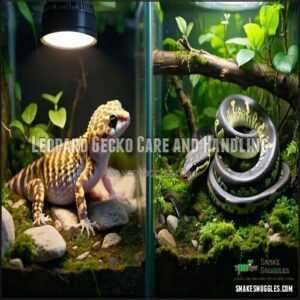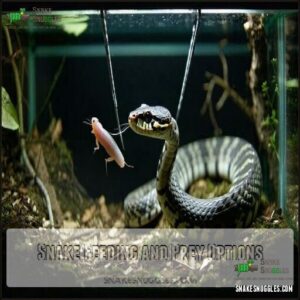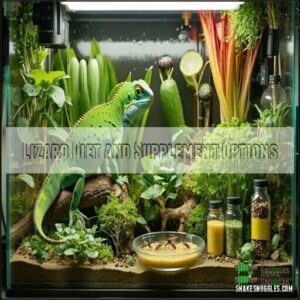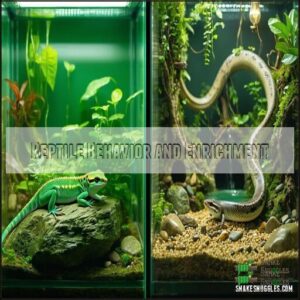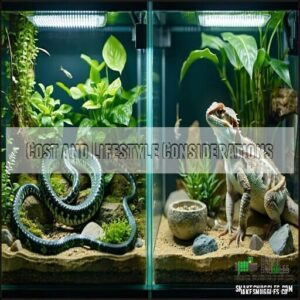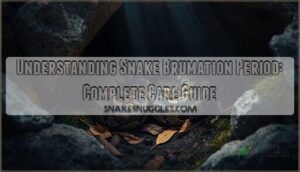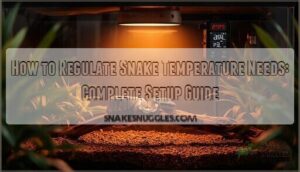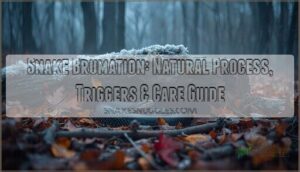This site is supported by our readers. We may earn a commission, at no cost to you, if you purchase through links.

Snakes are low-maintenance, need less frequent feeding (mice or frozen rodents), and can live longer, often exceeding 20 years.
Lizards, like geckos or bearded dragons, are more interactive, require daily feeding (insects, veggies), and have varied habitats.
Housing snakes takes less space since they’re often content to hide, while lizards need more elaborate enclosures.
Both are fascinating but handle differently—snakes slither calmly, while lizards can be quicker and more playful.
Think about your time, space, and comfort handling each. The right choice suits your schedule and personality.
Table Of Contents
- Key Takeaways
- Choosing Between Snakes and Lizards
- Popular Pet Snake Options
- Popular Pet Lizard Options
- Reptile Care and Maintenance
- Meeting Your Reptile’s Nutritional Needs
- Health and Veterinary Care
- Creating a Suitable Environment
- Reptile Behavior and Enrichment
- Cost and Lifestyle Considerations
- Long-Term Commitment and Responsibility
- Frequently Asked Questions (FAQs)
- What’s better, snake or lizard?
- What is the friendliest reptile pet?
- Who would win, a lizard or a snake?
- Can you trust a snake as a pet?
- What is the major difference between lizard and snake?
- Do pet snakes like being touched?
- Is it OK to have a lizard as a pet?
- What are common misconceptions about reptile pets?
- How do reptiles impact energy consumption at home?
- Do snakes and lizards pose escape risks?
- Conclusion
Key Takeaways
- Snakes are low-maintenance, need less frequent feeding, and thrive in simple enclosures, making them great for busy lifestyles.
- Lizards are interactive and playful but require daily feeding, larger enclosures, and more hands-on care.
- Snakes are calm and predictable, while lizards show diverse temperaments, often recognizing and interacting with their owners.
- Choose a snake if you want simplicity and longevity; pick a lizard if you’re ready for daily involvement and lively companionship.
Choosing Between Snakes and Lizards
When deciding between a pet snake or lizard, you’ll need to think about their behavior, care needs, and how they fit into your lifestyle.
Snakes are calm and low-maintenance, while lizards bring lively charm—choose the pet that matches your personality and lifestyle.
Each has unique traits, from a snake’s low-maintenance diet to a lizard’s active, curious nature.
Lizard and Snake Temperaments
In the context of temperaments, snake behavior is predictable, making them easier to handle, while lizard temperaments can range widely, from calm to moody.
Snakes rarely display aggression, but lizards, like iguanas, occasionally do.
Building trust is key for both pets, and surprisingly, some lizards may even recognize owners over time, adding a unique charm to their handling differences, which can make lizard handling more engaging.
Handling and Interaction Differences
Snake handling is typically straightforward—these reptiles are calm and have predictable temperaments.
Lizards, though, add a layer of intrigue, expressing moods through unique body language like flicking tails.
Building trust requires consistent, gentle interactions, while snakes rarely lash out, lizards may show slight aggression if mishandled.
Bonding potential varies, but both reptiles reward patient handling with fascinating behavior, and it’s crucial to watch escape risks—quick reactions go a long way!
Space and Housing Requirements
Space requirements depend on the reptile’s lifestyle.
A lizard habitat often needs a roomy pet tank with climbing branches, while a snake habitat thrives in snug enclosures.
Prioritize enclosure design that matches your pet’s instincts, like cozy hides for snakes or vertical areas for lizards.
You can find snake habitat products online.
Add habitat enrichment, maintain a thermal gradient, and guarantee proper humidity control to keep them comfortable.
Diet and Feeding Variations
If space and housing differ, so do their diets.
Snake feeding is a breeze—offer appropriately sized prey (like mice) weekly. They’re simple eaters but specific; live or frozen-thawed prey depends on the species.
Lizards, though, are demanding foodies, thriving on variety: insects, fruits, and greens. Lizard feeding often includes dietary enrichment: dusting crickets with calcium or carefully balancing veggies.
Snakes benefit from frozen rodent nutrition. Feeding frequency also varies—snakes eat less often, while lizards require more regular meals.
Each species’ diet reflects its unique needs, from supplementation to feeding schedules. Both reptiles reward planning (or patience) with thriving health and happy appetites. Think ahead!
Reptile Handling and Safety
Handling reptiles like a pro means staying calm and learning their quirks.
Always wash your hands to dodge Salmonella Risks. Use Safe Handling gear like gloves, especially with aggressive species.
Avoid quick moves to reduce stress and practice Bite Prevention. Handle in secure spaces to protect kids, pets, and the escape-obsessed.
- Quick Tip: Learning a reptile’s body language helps you spot signs of discomfort before things get dicey.
Popular Pet Snake Options
In the context of choosing a pet snake, some species are better suited for first-time owners while others require more experience.
Popular options like corn snakes and ball pythons are known for their manageable size, calm temperament, and simple care needs.
Corn Snake Characteristics and Care
Corn snakes are fantastic beginner reptiles, known for their calm demeanor and stunning morphs.
Corn snakes are easygoing, beautiful reptiles—perfect for beginners seeking a friendly, low-maintenance pet with striking patterns.
Setting up the perfect snake habitat guarantees they thrive. Here’s what to focus on:
- Enclosure Size: A 4’x2’x2’ tank works well, adding hides, branches, and decor to mimic their natural environment.
- Snake Temperature Control: Maintain warm basking spots at 90°F, cooler areas around 75°F, and nighttime drops to 68°F.
- Feeding Schedule: Offer frozen-thawed mice every 7-21 days, depending on age and size.
- Snake Health: Keep humidity between 65-75% to support shedding and prevent skin issues.
These "noodle roommates" are low-maintenance yet endlessly fascinating!
Ball Python Temperament and Handling
Ball pythons are the charmers of the snake world, known for their docile nature and shy, calm demeanor.
They rarely bite and are easy to care for, making them perfect for beginners. Regular, gentle handling helps build trust and reduces stress.
Here’s a quick guide to their behavior:
| Snake Trait | Behavior | Why It Matters |
|---|---|---|
| Handling Frequency | Weekly | Reduces stress, builds trust |
| Bite Risk | Very low | Great for beginners |
| Individual Variation | Slightly shy to confident | Adapt handling techniques |
Ball pythons truly thrive with patience and safe handling techniques, showcasing their endearing snake temperament.
Gopher Snake Diet and Feeding
Gopher snakes are low-maintenance in terms of meal preferences.
In captivity, stick to an easy-to-source diet of rodents like mice or small rats. Their feeding schedule? Once a week is plenty.
- Prey size matters—choose appropriately sized meals to prevent overfeeding.
- No need for supplementation—their diet provides all essential nutrients.
They’re champions of efficiency, keeping it simple compared to their wild diet of mammals and birds.
Kingsnake Habitat and Environmental Needs
Kingsnakes are champions at sneaking out, so always prioritize a secure snake habitat.
A 20-30-gallon enclosure offers the perfect space for adult kingsnakes to explore comfortably.
Set a temperature gradient between 75-85°F and keep humidity levels at 40-60%.
For substrate choice, aspen bedding or coconut husk works wonders.
Make it cozy with hiding spots they’ll adore and toss in a climbing branch – because who doesn’t love a little adventure?
- Enclosure size: 20-30 gallons
- Substrate: Aspen or coconut husk
- Temperature gradient: 75-85°F
- Humidity levels: 40-60%
Popular Pet Lizard Options
If you’re considering a pet lizard, there are several beginner-friendly options worth exploring. From leopard geckos to bearded dragons, these reptiles offer fascinating personalities and manageable care routines.
Leopard Gecko Care and Handling
Leopard geckos are a fantastic choice if you’re new to reptiles.
With their gentle nature, lizard handling feels less like a chore and more like a hobby. They’re low-maintenance but thrive with proper lizard care, including regular cleaning and Habitat Enrichment.
Watch out for common issues like Gecko Shedding Problems or Tail Dropping, which are manageable with attention.
Plus, their striking Leopard Gecko Morphs make them extra exciting! These geckos even brumate, adding another layer of fascination to their care.
Bearded Dragon Diet and Nutrition
A healthy bearded dragon depends on a balanced lizard diet.
Here’s how you can nail pet feeding:
- Insects: Offer crickets and mealworms daily. Use insect gutloading for max nutrition.
- Veggies: Mix kale, collard greens, and sweet potato for a colorful vegetable variety.
- Supplements: Practice calcium dusting on meals for bone health.
Hydration methods include shallow water dishes or light misting.
Crested Gecko Habitat and Environmental Needs
Crested geckos thrive in a cozy lizard habitat with plenty of vertical climbing space.
A 20-gallon enclosure with a secure lid is perfect. Keep humidity levels at 60-80%, mist daily, and include a temperature gradient of 68-75°F.
Use soft lighting designed for nighttime gecko activity. Add branches, vines, and mossy substrate for comfort.
| Need | Requirement | Why It Matters |
|---|---|---|
| Arboreal Setup | Vertical space | Promotes climbing fun |
| Humidity Levels | 60-80% | Keeps skin hydrated |
| Temperature Gradient | 68-75°F | Guarantees comfort |
| Lighting Needs | Soft, low-light | Mimics natural cycles |
Iguana Temperament and Space Requirements
Iguanas have a feisty lizard temperament and aren’t afraid to tail-whip if annoyed, so handle them cautiously.
Their space requirements are no joke—plan for an enclosure size of at least 6x6x6 feet.
To keep them happy:
- Provide ample climbing space in their habitat.
- Prioritize their social needs with regular interaction.
- Respect their moods to curb iguana aggression.
Reptile Care and Maintenance
Keeping a pet reptile means managing specific care needs like temperature, humidity, and hygiene to keep them healthy and comfortable.
Whether you choose a snake or a lizard, their enclosures require consistent maintenance and thoughtful setup to mimic their natural habitat, ensuring they have the best environment to thrive, with specific care needs.
Temperature and Humidity Control
Keeping your reptile’s habitat cozy starts with managing temperature and humidity levels.
Snakes and lizards thrive when their enclosures offer thermal gradients and balanced humidity that mimic their natural environment.
- Set warm and cool zones using heating systems.
- Mist the enclosure to maintain proper humidity levels.
- Monitor conditions with thermostats and hygrometers.
- Many owners purchase a quality reptile thermostat for precise control.
- Make certain airflow avoids cold drafts while preserving warmth.
- Adjust for seasonal changes to keep them comfortable year-round.
No reptile enjoys a tropical sauna or arctic chill!
Lighting and UVB Requirements
For reptiles, lighting isn’t just a glow—it’s life.
UVB lighting supports calcium absorption and vitamin D3 production, key for avoiding weak bones.
Snakes rarely need UVB benefits, but lizards rely on precise light cycles and basking lamps for energy and digestion.
Use a lighting spectrum that mimics nature.
Remember, even nocturnal species need a balanced photoperiod.
So, set up UV lighting to keep your scaly companion thriving in their habitat.
Substrate and Decor Options
A perfect reptile habitat starts with the right substrate types. Choose options like coconut fiber, bioactive substrate, mulch, or Aspen shavings, considering burrowing needs and humidity control.
Add safe, easy-to-clean decor like rock formations, branches, or artificial plants to create a natural feel. Make sure your setup flows well with your pet’s instincts—snakes love tight spaces, while lizards enjoy climbing and exploring.
Consistent cleaning is important, so be sure to follow a regular cleaning schedule to maintain a healthy environment. Regular cleaning frequency keeps things fresh and hygienic, ensuring your scaly friend’s home stays cozy and safe, not a reptile bachelor pad gone wild!
Cleaning and Hygiene Practices
A clean enclosure keeps your reptile healthy and happy.
Practice daily waste removal and wipe down surfaces with reptile-safe cleaners for effective enclosure sanitation.
Deep clean weekly, replacing substrate and scrubbing decor.
Don’t overlook water hygiene; refresh water bowls often to prevent bacteria.
Regular cleaning helps with shedding management and prevents odors.
Wash your hands afterward to avoid spreading bacteria like Salmonella.
With routine hygiene practices, pet cleaning becomes manageable, keeping your scaly friend thriving.
Meeting Your Reptile’s Nutritional Needs
Feeding your reptile the right diet is essential for keeping them healthy and active.
While their nutritional needs can vary substantially, many lizards thrive on a mix of fruits, vegetables, and insects.
Your choice of pet is a key factor in meal planning, as snakes usually prefer frozen rodents.
Snake Feeding and Prey Options
Feeding your snake is straightforward once you know the basics. The snake diet revolves around choosing prey size that matches the snake’s thickest part.
Frozen prey is safer and more ethical than live feeding. Many owners source quality frozen rodents for their snakes.
Most snakes eat once a week, keeping things simple.
- Fully thaw frozen prey—it should feel room temperature, not icy.
- Feed at night for nocturnal snakes.
- Use feeding tools to avoid accidental bites.
Lizard Diet and Supplement Options
Your lizard’s health thrives on variety and balance.
Start with Insect Gutloading—feeding crickets or mealworms nutritious food before offering them.
Include a Vegetable Variety, like collard greens or squash, to keep meals interesting.
Don’t forget Calcium Sources with Vitamin D3 to boost bone strength.
Stick to Supplement Schedules for reptile nutrition supplements, ensuring ideal lizard care.
Balanced meals lead to happy, healthy lizards!
Fresh Water and Hydration Needs
Staying hydrated isn’t just for humans—your reptile depends on it, too! Snakes and lizards both need constant access to water for drinking, soaking, and maintaining proper humidity levels.
Provide chlorine-free water daily to meet their needs and prevent shedding problems caused by low humidity. Keep an eye out for dehydration signs, like wrinkled skin or lethargy.
- Use a water dish large enough for your snake or lizard to sip and soak.
- Check water sources daily, ensuring they’re clean and fresh.
- Keep humidity levels steady to support hydration and shedding.
Vitamin and Mineral Supplementation
Maintaining your reptile’s health starts with the right balance of vitamins and minerals.
For strong bones, use calcium supplements, lightly dusting lizard or snake food weekly. If UVB lighting isn’t ideal, head toward D3 supplementation to boost energy levels and overall snake and lizard health.
Multivitamin use, recommended monthly, supports appetite and liveliness—especially when combined with gut-loading insects in a lizard diet. Consistent feeding schedules can also promote better digestion.
Watch out for soft bones or sluggish behavior as signs things aren’t quite right. With thoughtful care, like offering UVB alternatives and quality calcium sources, your reptile will thrive in its happy, scaly world.
Health and Veterinary Care
Keeping your reptile healthy means understanding common issues like respiratory infections or scale problems and knowing when to seek help.
Finding a vet who’s experienced with snakes or lizards can be tricky, but it’s essential for preventative care and long-term wellness.
Common Health Issues in Snakes
Shedding gone wrong or wheezing that sounds like a broken accordion? Snake health needs care and attention. Keep an eye out for trouble like scale rot, respiratory infections, or mites, which thrive in messy habitats.
Nidoviruses may cause respiratory diseases, too, or your slithering friend might develop a bite infection if you’re not careful.
Stay ahead of snake care with these signs:
- **Wheezing or sluggish behavior?
** Check for respiratory disease.
- **Crusty scales or open sores?
** Could be scale rot.
- **Lethargic movements?
** Warning of serious trouble.
- **Unwashed hands?
** Salmonella risk, for you.
Common Health Issues in Lizards
Did you know poor habitats can spark lizard health troubles?
Common diseases like metabolic bone disease, respiratory diseases, and scale rot stem from bad UVB lighting or diets.
Catching issues early, like subtle skin changes, prevents bigger problems, and injury prevention is key, along with balanced nutrition to avoid issues like Nidovirus.
Keep an eye out for signs of Nidovirus or Salmonella risks.
A little vigilance saves your reptile—and your vet bills.
Finding a Reptile-Savvy Veterinarian
Finding a reptile-savvy veterinarian can sometimes feel like cracking a safe without the code.
The key? Look for a vet with the right qualifications and reptile experience. Specialized veterinary care is essential for handling reptile diseases and emergencies.
Here’s your checklist:
- Ensure vet qualifications include exotic or herpetology training.
- Confirm experience with reptile health and diseases.
- Use reputable vet locator tools to find local vets.
- Ask herp communities for specialist referrals.
- Avoid clinics unfamiliar with reptiles or lacking emergency care.
Preventative Care and Regular Check-Ups
Don’t wait for a crisis—regular reptile health checks and preventative care keep your scaly friend thriving.
Beyond emergencies, a visit to a reptile vet can catch issues early, like parasite prevention or shedding issues.
Create a routine that includes hydration monitoring, weight management, and smart quarantine protocols for new pets.
| Issue | Prevention Tip | Vet’s Role |
|---|---|---|
| Parasites | Sanitize enclosure | Screen for parasites |
| Shedding issues | Boost humidity | Treat retained shed |
| Infections | Clean minor injuries | Suggest antibiotics |
| Respiratory woes | Increase ventilation | Diagnose diseases |
| Salmonella risk | Wash hands often | Offer safe practices |
Healthy habits, happy reptiles!
Creating a Suitable Environment
Designing the perfect reptile home is like crafting a miniature world suited to your pet’s needs.
An enclosure setup should balance comfort and practicality, whether it’s for a snake habitat or a lizard habitat.
Focus on essentials like:
- Thermal gradients: Set up basking spots and cooler retreats to mimic natural temperature zones.
- Substrate choices: Use coconut fiber, reptile carpet, or aspen shavings for terrain that feels just right.
- Ventilation systems: Maintain proper airflow, especially near heat sources, to maintain a cozy climate.
For lizards, humidity control is key—invest in a misting system and hygrometer.
Maintaining optimal breeding weight is vital for successful snake reproduction.
Proper snake care needs precise enclosure size and thoughtful lighting, ensuring your scaly friend feels right at home.
Reptile Behavior and Enrichment
Understanding your reptile’s behavior is key to keeping it healthy and happy, whether it’s a curious lizard or a laid-back snake.
By offering proper enrichment, like hiding spots or climbing structures, you can create a stimulating and satisfying environment for your pet.
Snake Behavior and Enrichment Options
Turn your snake habitat into a dynamic playground! Enrichment matters for snake care, so mix in scent enrichment, rotating hides, and fresh climbing opportunities.
Weekly scent changes can spark exploration instincts, helping reduce boredom. Bi-weekly hide rotations meet their natural hiding needs, building confidence and lowering stress.
Add logs, tunnels, or branches monthly to encourage activity and support shedding behavior. Watch for curious tongue flicking during these changes—it’s their way of showing contentment.
Enrichment isn’t just about entertainment; it’s key to proper snake behavior and overall social interaction!
Lizard Behavior and Enrichment Options
A lizard’s day can be as exciting or dull as the environment you provide. Keeping things fresh with creative enrichment options is key to their happiness.
- Use puzzle feeders to challenge foraging instincts and make mealtime fun.
- Add rock piles, climbing branches, or hammocks for environmental enrichment.
- Stimulate their senses with scented herbs or oils for sensory stimulation.
- Train them using a ball-on-stick reward system for gentle species socialization needs.
Watching for behavioral cues like glass surfing helps fine-tune their enrichment strategies.
Providing Hiding Places and Visual Barriers
Your pet lizard or pet snake needs secure hiding spots to feel at ease.
Use natural barriers like cork bark walls, hollow logs, or dense artificial plants for a stress-free pet enclosure.
Strategically place shelters on both warm and cool sides for species needs and natural behaviors.
Skip flimsy makeshift covers—nobody likes collapsing caves!
With hiding variety, you’ll create an enclosure that’s as enriching as it’s safe and secure.
Rotating Toys and Enrichment Items
Mixing up your reptile’s habitat keeps them curious and active, like giving them a new playground.
Rotating enrichment items is great for mental health and behavioral stimulation.
Here are three simple ideas:
- Add climbing toys like sturdy branches or ladders.
- Use puzzle feeders to combine fun and feeding.
- Introduce intriguing textures, such as tunnels or smooth rocks, for sensory enrichment.
Cost and Lifestyle Considerations
When deciding between a pet snake or lizard, it’s important to think about your budget, daily routine, and how much care you’re ready to provide.
Both reptiles come with unique costs and time needs, so knowing what fits your lifestyle can save you stress—and maybe some cash, too, by considering your lifestyle.
Initial Cost and Setup Expenses
Getting started with your new reptile means planning for setup costs.
Tanks vary—small ones might run $20, while advanced terrariums cost $500 or more.
Heating systems, lighting needs, substrate choice, and ventilation costs add up, especially for lizards requiring specialized equipment.
Stick to basics like hides and minimal gear at first to manage pet care costs effectively.
Ongoing Care and Maintenance Costs
Keeping a reptile isn’t cheap.
Food expenses stack up quickly, with lizard diets often pricier than snake meals. Heating costs, lighting replacement, and enclosure upkeep are non-negotiable to maintain health.
Don’t overlook vet bills—exotics need occasional check-ups. While pet care costs vary, long-term costs add up over a pet’s lifespan.
Staying consistent guarantees pet health, but it’s not for the faint-hearted—or light-walleted! Reptiles reward commitment with fascinating companionship.
Time Commitment and Lifestyle Considerations
Balancing life and pet care? Snakes often fit easier into busy schedules.
Their feeding schedules are limited to weekly or bi-weekly meals, making them great for low-maintenance pet owners. Lizards, on the other hand, thrive on daily interaction and diets requiring more attention.
Families with packed routines might find snakes less disruptive, while lizards demand hands-on attention. Consider your personal schedule and vacation planning—snakes are quieter and require less time, whereas lizards bring energy and charm but with higher pet care requirements.
Choose wisely to match your lifestyle and long-term pet ownership duration, ensuring you select a pet that fits well with your ability to provide the necessary care and attention, which is crucial for happy pets.
Travel and Reptile Sitter Arrangements
Traveling? Your pet’s comfort matters!
Reliable reptile sitters or specialized reptile boarding facilities can ease your worries.
Provide clear instructions: feeding schedule, enclosure security, emergency protocols, and transportation options if needed. Not all sitters handle reptiles, so vet their experience first.
Travel costs can add up, but peace of mind is priceless. Prep well, and your scaly friend will thrive while you’re away, with reliable reptile sitters.
Long-Term Commitment and Responsibility
When choosing between a pet snake or lizard, think about how much time and care you’re ready to commit over several decades.
Snakes often live longer, but both reptiles need consistent attention, proper habitats, and ongoing maintenance to thrive, which requires a significant commitment to their care, including providing the right environment and proper habitats.
Reptile Lifespan and Long-Term Care
Reptiles are no short-term commitment. With average lifespans ranging from 10 to 30+ years, caring for a snake or lizard means planning for the long haul.
Some species’ longevity might even lead them to outlive their owners, requiring serious thought about their future. Here’s what to keep in mind:
- Know their lifespan: A lizard’s or snake’s lifespan depends on the species—corn snakes can live 20+ years, while geckos reach up to 20.
- Health implications: Aging reptiles need more care, including veterinary visits and adjusted enrichment.
- End-of-life care: Be ready for decisions about housing upgrades or health-related expenses.
Reptiles are rewarding pets, but their long-term commitment demands steady patience and planning.
Commitment to Providing Proper Care
Owning a reptile means stepping into a long-term relationship with a pet that counts on you for everything—habitat maintenance, dietary needs, and even handling frequency.
With lifespans reaching decades, this pet care commitment isn’t short-lived.
Veterinary access is indispensable, as is meeting their unique needs daily.
A longterm commitment to reptile care guarantees they thrive, and while they won’t wag their tails in gratitude, your effort will keep them happy and healthy—no slacking allowed!
Researching and Preparing for Reptile Ownership
Bringing a reptile into your life isn’t just a spontaneous decision—it’s a lifelong commitment backed by thorough pet research. Start by doing detailed Species Research to match your personality and lifestyle with your pet’s needs. Are you ready for a snake’s diet of thawed rodents or a lizard’s veggie-packed meals?
Next, think about Habitat Planning. Every species needs a carefully controlled setup. From heating lamps to proper substrates, your checklist should cover it all.
Don’t overlook these must-dos:
- Legal Considerations: Some species may be restricted in your area.
- Budgeting Checklist: Factor in setup costs, food, and maintenance supplies.
- Sourcing Reputable Breeders: Avoid shady sellers. Always prioritize your pet’s health.
- Vet Connections: Find someone who truly understands exotic pet care.
Take the time—your future pet deserves it!
Ensuring a Reptile-Friendly Home Environment
You’ve done the homework; now let’s create a truly reptile-friendly environment.
Follow these key steps for a cozy, scaly paradise:
- Temperature Matters: Use heating and lighting systems to craft thermal gradients in your reptile’s enclosure. This keeps them comfy and thriving.
- Moisture Magic: Monitor humidity levels—desert reptiles need drier conditions, while others prefer it misty.
- Smart Setup: Choose safe substrates and confirm proper ventilation systems. Optimize enclosure size to match your pet’s needs, giving space to climb or hide. Perfect habitat design means happier reptiles and owners alike!
Frequently Asked Questions (FAQs)
What’s better, snake or lizard?
Choosing between a snake and a lizard is like deciding between a quiet roommate and an active one.
Snakes are low-maintenance and calm, while lizards are lively but require more attention.
It depends on your lifestyle!
What is the friendliest reptile pet?
Leopard geckos are undoubtedly the friendliest reptile pets.
They’re calm, easy to handle, and recognize their owners over time.
Their small size, laid-back personality, and adorable expressions make them a favorite for beginners and reptile enthusiasts alike, which contributes to their reptile popularity.
Who would win, a lizard or a snake?
Imagine a chess match—lizards rely on agility and quick decisions, while snakes use precision and patience.
The winner depends on size, species, and setting, but in general, snakes often have the upper hand.
Can you trust a snake as a pet?
You can trust a pet snake to be predictable if its needs are met—proper habitat, feeding, and handling.
While they don’t "bond," their behavior is straightforward, making them low-maintenance and reliable companions.
What is the major difference between lizard and snake?
The biggest difference is legs—lizards have them, snakes don’t.
Snakes slither and rely on their muscles for movement, while lizards crawl or climb.
Lizards often seem busier, while snakes are typically more laid-back.
Do pet snakes like being touched?
Snakes don’t crave touch like a dog or cat, but some tolerate gentle handling.
Species like ball pythons and corn snakes often stay calm when held.
Handle them carefully to build trust over time.
Is it OK to have a lizard as a pet?
Having a lizard as a pet is absolutely fine.
They’re low-maintenance, fascinating to watch, and offer unique companionship.
Just be ready for long-term care, proper habitat setup, and feeding routines adapted to their specific needs.
What are common misconceptions about reptile pets?
People often think reptiles are emotionless, hard to care for, or all dangerous.
They’ve got personalities, manageable needs, and most aren’t venomous.
With proper setups, they’re fascinating companions—not just scaly decorations, and having manageable needs makes them great pets.
How do reptiles impact energy consumption at home?
It’s funny how owning reptiles can lower energy costs.
They need heating and lighting, but compact UV and heat lamps use less energy than traditional HVAC systems.
Strategic placement guarantees comfort without spiking your electricity bill, which is a key factor in managing energy costs.
Do snakes and lizards pose escape risks?
Escaping is a real risk if enclosures aren’t secure.
Snakes are sneaky, often squeezing through tiny gaps, while lizards, being climbers, can scale their way out.
Always double-check tank locks, lids, and barriers to prevent escaping, as it is crucial for maintaining the safety and security of the enclosure.
Conclusion
Choosing between a pet snake and a pet lizard is like weighing simplicity against interaction.
Snakes, with their low-maintenance care and longer lifespans, are perfect if you prefer minimal daily involvement.
Lizards, on the other hand, offer more playful experiences but require more time, space, and effort.
Think about your schedule, comfort level, and handling preferences, whether it’s a calm snake or an active lizard, there’s a reptile companion to perfectly match your lifestyle needs.



